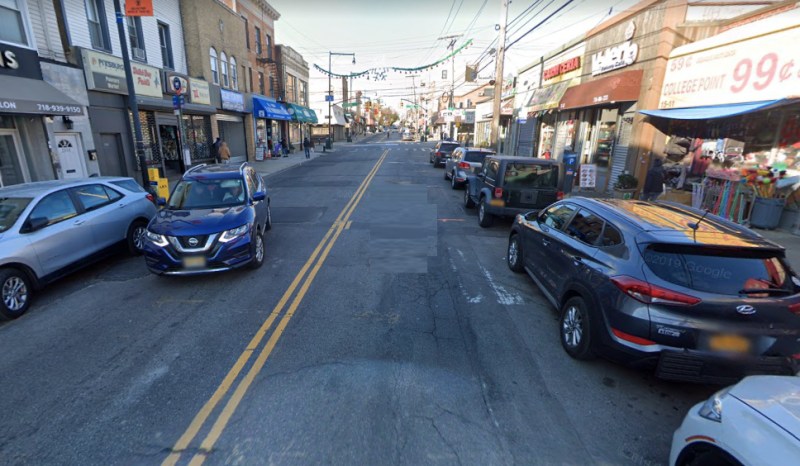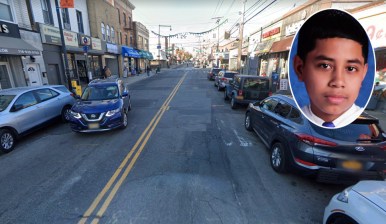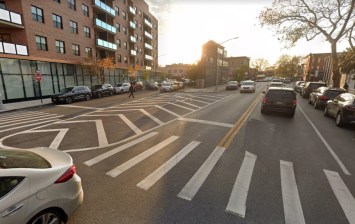Teen Cyclist Killed in College Point — Evidence of the Decline of Vision Zero

The teenager who was struck by a reckless hit-and-run driver on the notoriously dangerous commercial part of College Point Boulevard in College Point last week has died, cops said on Thursday — the latest reminder of a bloody 12 months that suggest that Mayor de Blasio’s Vision Zero initiative has stalled.
Police said that Darwin Durazno, 16, of Corona, was cycling southbound on the hectic and frequently obstructed boulevard just north of 18th Avenue on June 4 at around 10:30 p.m. when the driver of a northbound Toyota Camry swerved into the ongoing traffic lane, possibly to get around a double-parked car or truck — and slammed directly into Durazno, causing severe head trauma.
Durazno was taken to Jacobi Hospital in The Bronx, where he died three days later. The driver, however, fled, cops said. Police discovered the murder weapon on 15th Avenue — just one and a half blocks from the crash site. Witnesses described the driver as a male, 20-30 years old, last seen wearing a long-sleeved blue shirt, with a white t-shirt underneath and blue jeans below as he fled on foot from the parked vehicle, cops said.
The investigation is ongoing, police said.
Durazno’s death is the believed to be the fourth death of a cyclist this year, but overall, the last 12 months have been the bloodiest of de Blasio’s tenure. And the bloodshed has continued this year — the city reached 100 traffic deaths by the end of May — a grim milestone that is typically not reached until July.
Transportation Alternatives Executive Director Danny Harris is not impressed at the pace that the mayor is using to get to the “zero” of Vision Zero:
“As New York City opens back up, traffic violence is killing a record number of our neighbors,” he said in a statement. “The numbers in Queens are especially alarming. May, 2021 was the deadliest May on Queens streets since Vision Zero began, with 12 fatalities. The previous record was eight.”
Also in Queens, so far this year, 27 people have been killed in road violence — the deadliest first five months of a year for Queens since 2014, Harris added.

“Our leaders need to treat traffic deaths like the public health epidemic it is,” he said. Meanwhile, a package of street safety bills is languishing in Albany — with the legislative session set to close today.
“If Albany closes this session without delivering this cure for traffic deaths, more New Yorkers will die,” Harris said. “We call on Speaker Heastie and Majority Leader Stewart-Cousins to advance Sammy’s Law before session ends today and save lives on our streets.”
A recent Transportation Alternatives polls showed that 68 percent of New York City voters support lowering speed limit from 25 to 20 mph — but the city needs Albany’s approval for that.
Lower speed limits have been shown to reduce the likelihood of fatality in crashes. That could help on hectic, chaotic College Point Boulevard, one of the most dangerous places in the city.
In 2019*, there were 296 reported crashes, injuring three cyclists, 16 pedestrians and 24 motorists on just the mile strip between the Whitestone and Van Wyck expressways. And north of that area, where Durazno was killed, is also a danger zone because it alternates between a commercial strip with frequent double parking and segment with a wide driving lane that encourages speeding.
In 2019*, in the 1.3-mile stretch between 28th and Fifth avenues, there were 96 reported crashes, injuring one cyclist, three pedestrians and 11 motorists.
The Flushing area is well known for its hazards to pedestrians. In 2019, statistics showed that the neighborhood — represented by Council Member Paul Vallone and Peter Koo, both opponents of street safety measures — was the most deadly for pedestrians in all of Queens.
* Streetsblog is using 2019 as a benchmark for full-year traffic stats because 2020 numbers are skewed because of the pandemic.
Update: The grim 100-death toll was reached before the end of May, not April as originally reported, owing to an error in Transportation Alternatives data.


